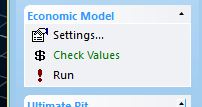|
|
Find Your Way Around |
Your User Interface

|
A Datamine eLearning course is available that covers functions described in this topic. Contact your local Datamine office for more details. |

Your application's user interface is design to be flexible and simple to use. You can customize just about every part of it.
A ribbon system is used to deliver key functionality, whilst control bars help you to work with specific project data, including strategic planning and reference data. Control bars are provided that are dedicated to a particular element of your system, such as the optimization workflow, accessing and formatting project data. 3D data can be displayed in a variety of ways using a range of data windows. There are also tool bars, strategic results tables and charts and more.
This topic provides a high-level view of the way your product presents strategic planning functions.
Ribbon Interface

Your application adopts a ribbon system to deliver the majority of
its core functionality, moving away from the toolbar-heavy approach
used in previous versions. Context-sensitivity means that only the
commands relevant to your current Data View (see below) will be displayed
and/or enabled.
The out-of-the-box configuration has been designed to serve the vast majority of geological modelling needs, segregating functions into domain-based command groups and tabs whilst keeping commonly-used commands available at all times.
Ribbons are also available for customization to allow you to set up your user interface the most appropriate way for your role and tasks.
Context-sensitive information for every ribbon command has been provided (way in advance of the previous tooltips) to allow you to research your command choice before you activate it. This information isn't provided instead of detailed online Help, it is provided in addition to comprehensive digital documentation.

This control bar contains managed workflow tasks for Optimization, Reports, Visualize and Notes. You'll use it a lot when developing planning projects. More...

As in previous versions of Studio, dedicated (linked) data windows are provided to deliver the most appropriate context for the type of work being performed. By default, the following data views are displayed:
-
Start Window
The landing page. The Start window is displayed on initial startup and is available throughout your project session. It can be used to view the latest online/offline information relating to your product, access recently-opened projects, create a new project or browse for a project. -
Summaries, Reports and Charts: represents the results of each phase of your strategic planning project. Summaries and reports are presented in a spreadsheet-style view and chart windows support these results.
Find out more about Summaries...
Find out more about Reports...
Find out more about Charts... -
3D Windows
3D windows offer a combined visualization and engineering interface to complete your CAD-style engineering tasks in a flexible environment. Many interactive commands are available to make the geological modelling process intuitive and rich in 3D visual feedback. A 3D window also allows you to spawn independent, floating versions of the 3D view.
Find out more about 3D windows...
Find out more about external 3D windows... -
Plots Window
Report-ready plots, logs, charts and other supporting data can be constructed from your 3D data quickly and easily with the Plots window. Working with the same data displayed in other data windows (including 3D), and with a powerful template function, you can create detailed and unequivocal standard reports in minutes.
Find out more about the Plots window...
Other data windows are displayed either on request, or automatically as a result of creating a particular type of data:
-
Logs Window
Strip log display and configuration, again based on the same underlying data as shown in other data views. This window is automatically displayed when a new Log Sheet is created, and will be automatically displayed if a project containing log data is loaded.
Find out more about the Logs window -
Tables Window
Context-sensitive data table formatting options can be found in the Tables window, allowing you to create a formatted view of your data objects using a wide range of display options.
Find out more about the Tables window...
Control Bars

Control bars are a great way to access data-specific functions and processes. Anyone familiar with Studio 3 will feel at home here, but for users not familiar with this facility, a wealth of information is available here to help you make the most of these powerful tools:
|
|
Related Topics |
|
|
The Planning WorkspaceCustomizing
Your Interface
Ribbon Reference Selection Control Bars Overview Data Control Bars Overview Output Control Bars Overview |
Copyright © Datamine Corporate Limited
MIN 20044_00_EN


